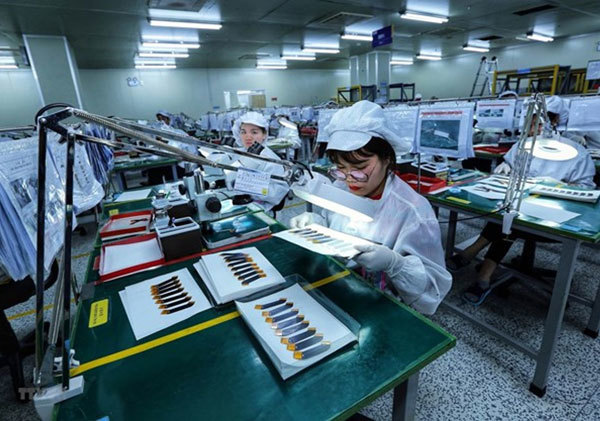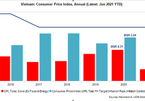 |
| Women work at an electronic company at the Yen Phong Industrial Park. - Photo: VNA |
According to the first scenario, the country’s gross domestic product (GDP) would grow 5-5.5%, depending on the speed and effectiveness of the vaccination rollout, the re-opening of the economy and the recovery and resumption of major export markets.
In the second scenario, if the vaccination program is not quick enough and lockdown and social distancing drag on, there will be more of an adverse impact to the economy and increased pressure on supply chains, and GDP may only reach 3.5-4%.
“We had high expectations for the economy this year after the strong performance in 2020 where Vietnam was one of the very few countries to showcase positive GDP growth,” said Tim Evans, CEO of HSBC Vietnam.
The year started very strongly with exports showing positive momentum on the back of the opening of the economies in the West and the benefits of the large number of Free Trade Agreements that Vietnam had signed.
“What no one predicted was that the coronavirus would continue to mutate in a way that would make it far more virulent. Along came the Delta variant – a variant that spread so fast that it made it much harder to control,” Evans said.
The impact of this variant as it spread across the country, especially the economic heartland of Vietnam in the south, meant a swift re-introduction of lockdowns and travel restrictions.
These in turn led to a decline in foreign direct investment (FDI) into the country. FDI in registered capital declined 11.1% year-on-year from January to July 2021.
However, on a more positive note, the disbursed capital was up 3.8% year-on-year in the January-July period.
Another impact of the lockdowns was that consumption took a significant hit. Retail sales fell by 19.8% in July, the most since April 2020.
The impact on the manufacturing sector intensified further in August and the ongoing restrictions lead to the temporary closure of certain businesses, while social distancing measures resulted in further declines in output, new orders, purchasing and, ultimately, employment.
This in turn led to unprecedented supply-chain disruptions which were exacerbated by challenges around transportation and pressure on capacity at the country’s ports. As a consequence, industrial production declined for the first time in five months, due to weaker manufacturing output.
Unsurprisingly, the most recent August data reveals the pain that Vietnam’s economy is facing. The impact is significantly more severe than that during the three-week national lockdown in April 2020.
On the domestic front, private consumption saw a substantial hit, as mobility fell by as much as 60% on average from the pre-pandemic levels. This resulted in a 40% year-on-year reduction in retail sales.
HSBC’s current forecast for the 2021 GDP growth has been amended to 5.1% from the previous 7.1%, reflecting the severe impact of the fourth Covid-19 wave.
“The only way to come out of this situation is through active vaccination and ensuring that medical professionals have the resources to treat those who are most adversely impacted by the virus,” the HSBC CEO suggested.
“We believe consumption will bounce back sharply once the current Covid-19 wave subsides,” he added.
As the economy starts to reopen, supply chain challenges should subside, orders will resume and the FDI should resume its cadence given the Government’s consistent policies, hardworking workforce and a large number of FTAs.
Despite the current environment, Vietnam remains a highly attractive investment destination in the medium term. This is based on the country’s robust fundamentals which many investors will look through the present Covid volatilities.
Source: SGT

Vietnam: Economic growth pace accelerates in 2Q
Vietnam’s economic growth accelerated to 6.61% y/y in 2Q21, extending from an upwardly revised gain of 4.65% y/y in 1Q21.

2021 economic outlook remains positive despite COVID-19 resurgence
Data shows that industrial production index in the first five months of the year advanced 9.9 percent year-on-year, with manufacturing and processing up 12.6 percent.